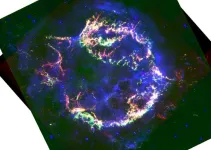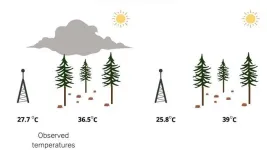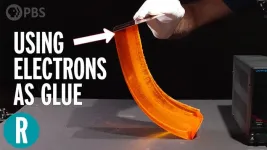(Press-News.org) Humans make nearly 35,000 decisions every day, from whether it’s safe to cross the road to what to have for lunch. Every decision involves weighing the options, remembering similar past scenarios, and feeling reasonably confident about the right choice. What may seem like a snap decision actually comes from gathering evidence from the surrounding environment. And often the same person makes different decisions in the same scenarios at different times.
Neural networks do the opposite, making the same decisions each time. Now, Georgia Tech researchers in Associate Professor Dobromir Rahnev’s lab are training them to make decisions more like humans. This science of human decision-making is only just being applied to machine learning, but developing a neural network even closer to the actual human brain may make it more reliable, according to the researchers.
In a paper in Nature Human Behaviour, “The Neural Network RTNet Exhibits the Signatures of Human Perceptual Decision-Making,” a team from the School of Psychology reveals a new neural network trained to make decisions similar to humans.
Decoding Decision
“Neural networks make a decision without telling you whether or not they are confident about their decision,” said Farshad Rafiei, who earned his Ph.D. in psychology at Georgia Tech. “This is one of the essential differences from how people make decisions.”
Large language models (LLM), for example, are prone to hallucinations. When an LLM is asked a question it doesn’t know the answer to, it will make up something without acknowledging the artifice. By contrast, most humans in the same situation will admit they don’t know the answer. Building a more human-like neural network can prevent this duplicity and lead to more accurate answers.
Making the Model
The team trained their neural network on handwritten digits from a famous computer science dataset called MNIST and asked it to decipher each number. To determine the model’s accuracy, they ran it with the original dataset and then added noise to the digits to make it harder for humans to discern. To compare the model performance against humans, they trained their model (as well as three other models: CNet, BLNet, and MSDNet) on the original MNIST dataset without noise, but tested them on the noisy version used in the experiments and compared results from the two datasets.
The researchers’ model relied on two key components: a Bayesian neural network (BNN), which uses probability to make decisions, and an evidence accumulation process that keeps track of the evidence for each choice. The BNN produces responses that are slightly different each time. As it gathers more evidence, the accumulation process can sometimes favor one choice and sometimes another. Once there is enough evidence to decide, the RTNet stops the accumulation process and makes a decision.
The researchers also timed the model’s decision-making speed to see whether it follows a psychological phenomenon called the “speed-accuracy trade-off” that dictates that humans are less accurate when they must make decisions quickly.
Once they had the model’s results, they compared them to humans’ results. Sixty Georgia Tech students viewed the same dataset and shared their confidence in their decisions, and the researchers found the accuracy rate, response time, and confidence patterns were similar between the humans and the neural network.
“Generally speaking, we don't have enough human data in existing computer science literature, so we don't know how people will behave when they are exposed to these images. This limitation hinders the development of models that accurately replicate human decision-making,” Rafiei said. “This work provides one of the biggest datasets of humans responding to MNIST.”
Not only did the team’s model outperform all rival deterministic models, but it also was more accurate in higher-speed scenarios due to another fundamental element of human psychology: RTNet behaves like humans. As an example, people feel more confident when they make correct decisions. Without even having to train the model specifically to favor confidence, the model automatically applied it, Rafiei noted.
“If we try to make our models closer to the human brain, it will show in the behavior itself without fine-tuning,” he said.
The research team hopes to train the neural network on more varied datasets to test its potential. They also expect to apply this BNN model to other neural networks to enable them to rationalize more like humans. Eventually, algorithms won’t just be able to emulate our decision-making abilities, but could even help offload some of the cognitive burden of those 35,000 decisions we make daily.
####
The Georgia Institute of Technology, or Georgia Tech, is one of the top public research universities in the U.S., developing leaders who advance technology and improve the human condition. The Institute offers business, computing, design, engineering, liberal arts, and sciences degrees. Its more than 47,000 undergraduate and graduate students represent 54 U.S. states and territories and more than 143 countries. They study at the main campus in Atlanta, at campuses in France and China, or through distance and online learning. As a leading technological university, Georgia Tech is an engine of economic development for Georgia, the Southeast, and the nation, conducting more than $1 billion in research annually for government, industry, and society.
END
A new neural network makes decisions like a human would
2024-07-15
ELSE PRESS RELEASES FROM THIS DATE:
Wojtusiak to use artificial intelligence to help caregivers with social isolation
2024-07-15
Janusz Wojtusiak, Professor, Health Administration and Policy, College of Public Health, is set to receive funding for the project: “An Artificial Intelligence Solution to Social Isolation and Longlines of Caregivers of People with Dementia.”
Wojtusiak and his graduate student Ghaida Alsadah will lay the foundation for a large study aimed at utilizing AI methods to address social isolation and loneliness among people who care for those with Alzheimer’s Disease and those suffering from dementia.
Addressing ...
You're just a stick figure to this camera
2024-07-15
Images
A new camera could prevent companies from collecting embarrassing and identifiable photos and videos from devices like smart home cameras and robotic vacuums. It's called PrivacyLens and was made by University of Michigan engineers.
PrivacyLens uses both a standard video camera and a heat-sensing camera to spot people in images from their body temperature. The person's likeness is then completely replaced by a generic stick figure, whose movements mirror those of the person it stands in for. The accurately animated stick figure allows a device relying on the ...
Scorching storms on distant worlds revealed in new detail
2024-07-15
Astronomers have created the most detailed weather report so far for two distant worlds beyond our own solar system.
The international study – the first of its kind – reveals the extreme atmospheric conditions on the celestial objects, which are swathed in swirling clouds of hot sand amid temperatures of 950C.
Using NASA’s powerful James Webb Space Telescope (JWST), researchers set out to capture the weather on a pair of brown dwarfs – cosmic bodies that are bigger than planets but smaller than stars.
These brown dwarfs, named collectively ...
JWST unveils stunning ejecta and CO structures in Cassiopeia A's young supernova
2024-07-15
July 15, 2024, Mountain View, CA -- The SETI Institute announced the latest findings from the James Webb Space Telescope (JWST) of the supernova remnant, Cassiopeia A (Cas A). These observations of the youngest known core collapse supernova in the Milky Way provide insights into the conditions that lead to the formation and destruction of molecules and dust within supernova ejecta. The study’s findings change our understanding of dust formation in the early universe in the galaxies detected by JWST 300 million years after the Big Bang. ...
UC Irvine Earth system scientists discover missing piece in climate models
2024-07-15
Irvine, Calif., July 15, 2024 — As the planet continues to warm due to human-driven climate change, accurate computer climate models will be key in helping illuminate exactly how the climate will continue to be altered in the years ahead.
In a study published in the Journal of Geophysical Research: Atmospheres, a team led by researchers from the UC Irvine Department of Earth System Science and the University of Michigan Department of Climate and Space Sciences and Engineering reveal how a climate model commonly used by geoscientists currently overestimates ...
Wildfire smoke has a silver lining: It can help protect vulnerable tree seedlings
2024-07-15
CORVALLIS, Ore. – Forest scientists at Oregon State University studying tree regeneration have found that wildfire smoke comes with an unexpected benefit: It has a cooling capacity that can make life easier for vulnerable seedlings.
An OSU College of Forestry collaboration led by faculty research assistant Amanda Brackett made the discovery while working to determine the effect of forest canopy cover on summer maximum temperatures near ground level.
The study’s goal was to describe how heat waves and other future climate conditions might affect canopy cover’s influence on temperature. The scientists used previously established heat stress responses of seedlings from ...
How does superglue work, and what the heck is electroadhesion? (video)
2024-07-15
WASHINGTON, July 15, 2024 — How would you stick a slice of banana to a sheet of copper? Until a few months ago, you couldn’t. But a new discovery called “hard-soft electroadhesion” enables chemists to stick almost any hydrogel to almost any metal, using nothing but an electric current. And you can unstick the materials simply by reversing the current. Recently reported in ACS Central Science, this astonishingly general phenomenon works with a wide variety of gels (including fruits, vegetables, meat and fish) and conductors (including metals and graphite). Join our host George as he attempts to replicate electroadhesion in his basement ...
Progression from pre-symptomatic to clinical type 1 diabetes after COVID-19 infection
2024-07-15
About The Study: Follow-up of youth with pre-symptomatic type 1 diabetes demonstrated that the COVID-19 pandemic was associated with an accelerated progression to clinical disease and that this acceleration was confined to those with COVID-19. Further studies are required to determine whether COVID-19 also accelerates progression to type 1 diabetes in adults and whether vaccination and monitoring for COVID-19 symptoms should be considered for individuals with pre-symptomatic type 1 diabetes.
Corresponding ...
Mental health of transgender youth following gender identity milestones by level of family support
2024-07-15
About The Study: The results of this study demonstrate that without a supportive family environment, gender identity development increases the risk of transgender youth attempting suicide or running away from home. Social services and community resources to establish supportive relationships between transgender children and their parents are essential.
Corresponding Author: To contact the corresponding author, Travis Campbell, Ph.D., email campbelt1@sou.edu.
To access the embargoed study: Visit our For The Media website at this link https://media.jamanetwork.com/
(doi:10.1001/jamapediatrics.2024.2035)
Editor’s ...
Use of massage therapy for pain
2024-07-15
About The Study: This study found that despite a large number of randomized clinical trials, systematic reviews of massage therapy for painful adult health conditions rated a minority of conclusions as moderate-certainty evidence and that conclusions with moderate- or high-certainty evidence that massage therapy was superior to other active therapies were rare.
Corresponding Author: To contact the corresponding author, Selene Mak, Ph.D., M.P.H., email selene.mak@va.gov.
To access the embargoed study: Visit our For The Media website at this link https://media.jamanetwork.com/
(doi:10.1001/jamanetworkopen.2024.22259)
Editor’s ...


